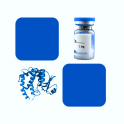
- Remove this product from my favorite's list.
- Add this product to my list of favorites.
Products
Viewed products
Newsletter
 |  |  |  |  |  |

Background
Fibroblast growth factor receptor 4 (FGFR4) is also known as CD334, JTK2, hydroxyaryl-protein kinase, TKF, protein-tyrosine kinase . The FGFR4 gene provides instructions for making a protein called fibroblast growth factor receptor 4. This protein is part of a family of fibroblast growth factor receptors that share similar structures and functions. These receptor proteins play a role in important processes such as cell division, regulating cell growth and maturation, formation of blood vessels, wound healing, and embryo development.The FGFR4 protein interacts with specific growth factors to conduct signals from the environment outside the cell to the nucleus. The nucleus responds to these signals by switching on or off appropriate genes that help the cell adjust to changes in the environment. In response, the cell might divide, move, or mature to take on specialized functions. Although specific functions of FGFR4 remain unclear, studies indicate that the gene is involved in muscle development and the maturation of bone cells in the skull. The FGFR4 gene may also play a role in the development and maintenance of specialized cells (called foveal cones) in the light-sensitive layer (the retina) at the back of the eye.
Source
Recombinant Human FGF R4, His Tag (FG4-H5228) is expressed from human 293 cells (HEK293). It contains AA Leu 22 - Asp 369 (Accession # P22455-1).
Predicted N-terminus: Leu 22
Molecular Characterization
This protein carries a polyhistidine tag at the C-terminus.
The protein has a calculated MW of 39.3 kDa. The protein migrates as 50-70 kDa under reducing (R) condition (SDS-PAGE) due to glycosylation.
Endotoxin
Less than 1.0 EU per μg by the LAL method.
Purity
>95% as determined by SDS-PAGE.
Formulation
Lyophilized from 0.22 μm filtered solution in PBS, pH7.4 with trehalose as protectant.
Reconstitution
Please see Certificate of Analysis for specific instructions.
For best performance, we strongly recommend you to follow the reconstitution protocol provided in the CoA.
Storage
For long term storage, the product should be stored at lyophilized state at -20°C or lower.
Please avoid repeated freeze-thaw cycles.
This product is stable after storage at:
-20°C to -70°C for 12 months in lyophilized state;
-70°C for 3 months under sterile conditions after reconstitution.
(1) "Treatment with dapagliflozin increases FGF-21 gene expression and reduces triglycerides content in myocardial tissue of genetically obese mice"
Di Vincenzo, Crescenzi, Granzotto et al
J Endocrinol Invest (2024)
(2) "scMultiome analysis identifies embryonic hindbrain progenitors with mixed rhombomere identities"
Kim, O'Rourke, Sagerström
Elife (2023) 12
(3) "scMultiome analysis identifies embryonic hindbrain progenitors with mixed rhombomere identities"
Kim, O'Rourke, Sagerström
bioRxiv (2023)
Showing 1-3 of 38 papers.
FGF-1, 50 µg - 145,00 €
FGF-2, 50 µg - 145,00 €
Recombinant human FGFR1 /CD331 Protein, His tag, 200µg - 468,00 €
Follow us